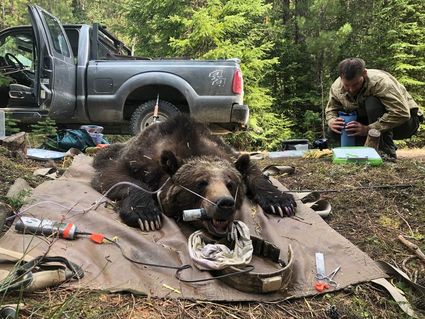FWS releases grizzly update
June 20, 2019

U.S. Fish and Wildlife Service photo
CAPTURED – Biologist Tyler Vent monitors grizzly bear 2003 during anesthetization in the Selkirk Mountains north of Idaho in May.
The U.S. Fish and Wildlife Service (FWS) has recently released the most recent Grizzly Bear Monitoring Update, reflecting data collected beginning May 2019.
According to Wayne Kasworm, FWS biologist, the Cabinet-Yaak began 2019 with six (two females, four males) collared grizzlies. Of the two females, one was seen with two new cubs and the other is most likely too young to reproduce.
As part of the grizzly augmentation project, two bears were introduced to the Cabinets during the summer of 2018. In August, a 2-year-old male was captured and released in the West Cabinets. The bear travelled extensively from there to Bonners Ferry, Idaho, and into the Yaak, British Columbia finally into the Porthill, Idaho area; it was here the bear killed several sheep. "Traps were set and the bear was captured," reads the report. Idaho Fish and Game and FWS "made a joint decision to euthanize the bear."
The other bear released, another male, was relocated in July 2018 in the West Cabinet, Spar Lake area. He was recently located 40 miles southeast of Kellogg, Idaho, after crossing the Clark Fork River a couple of times since his release, and then denning for winter in the West Cabinets.
FWS commented, "We do not expect to move another bear to the Cabinet Mountains this year as part of the continued augmentation effort."
Results from genetic samples taken in 2017 have been received by FWS. They report "notable results" including: "identification of several new offspring of augmented bears in the Cabinet Mountains, evidence that a male augmentation bear has reproduced, and total numbers of bears identified by 2017 sampling in each recovery area."
In all, seven augmentation offspring have been identified in the Cabinets from these samples. They have concluded that a 2-year-old male, released in 2011, has reproduced. Kasworm reported, "This is the first instance of new male genes in the population because of the augmentation effort."
"Out of 20 total bears released, at least 2 females (and now one male) are known to have reproduced," commented Kasworm. "These three individuals are responsible for 14 first generation offspring, 18 second generation offspring, and one third generation offspring."
When the augmentation project started in 1990, Kasworm believes the grizzly population to have been in the single digits. After releasing 4 bears between 1990 and 1994, there was a female who reproduced in 2004. Since 2005, and additional 16 bears have been released.
Through genetic testing and parental analysis, there is currently a population estimate of 25-20 in the Cabinet Mountains and another 25-30 in the Yaak, according to Kasworm.
"It is now a cooperative program where Montana Fish, Wildlife and Parks (FWP) captures the bears and U.S. Fish and Wildlife Service radio collars and monitors the bears," Kasworm reported, adding that FWP joined augmentation efforts in 2004.







Reader Comments(0)